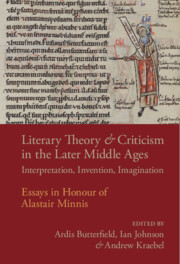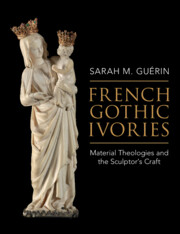Refine search
Actions for selected content:
36 results
11 - Islamic Receptions
- from Part II - The Christological Reception
-
-
- Book:
- The Cambridge Companion to Christology
- Published online:
- 15 September 2025
- Print publication:
- 02 October 2025, pp 180-198
-
- Chapter
- Export citation
101 - Diodore of Tarsus, Chronicon
-
- Book:
- The Fragmentary Greek Chronicles after Eusebius
- Published online:
- 11 September 2025
- Print publication:
- 24 July 2025, pp 176-179
-
- Chapter
- Export citation
Pusey, Scripture and Epistemology
-
- Journal:
- Journal of Anglican Studies , First View
- Published online by Cambridge University Press:
- 04 July 2025, pp. 1-9
-
- Article
- Export citation
8 - Sermons on the Ascension and Pentecost
- from Part II - Augustine’s Sermons on the Scriptures and Liturgical Feasts
-
-
- Book:
- The Cambridge Companion to Augustine's Sermons
- Published online:
- 26 May 2025
- Print publication:
- 12 June 2025, pp 152-168
-
- Chapter
- Export citation
Interpreting the Qur’an through the science of logic: Ibn ʿArafah al-Warġammī (d. 803/1401) on the dynamics of tafsīr and manṭiq
-
- Journal:
- Journal of the Royal Asiatic Society / Volume 35 / Issue 2 / April 2025
- Published online by Cambridge University Press:
- 06 June 2025, pp. 273-308
- Print publication:
- April 2025
-
- Article
- Export citation
Abraham, David, and the Problem of Exile in Calvin’s Theology
-
- Journal:
- Harvard Theological Review / Volume 118 / Issue 2 / April 2025
- Published online by Cambridge University Press:
- 30 July 2025, pp. 314-336
- Print publication:
- April 2025
-
- Article
- Export citation
38 - Hierarchies of Knowledge in the Works of Bede
-
-
- Book:
- The Intellectual World of Late Antique Christianity
- Published online:
- 05 October 2023
- Print publication:
- 26 October 2023, pp 729-751
-
- Chapter
- Export citation
36 - Ordering Emotional Communities: Modes of Knowing in Gregory the Great
-
-
- Book:
- The Intellectual World of Late Antique Christianity
- Published online:
- 05 October 2023
- Print publication:
- 26 October 2023, pp 690-704
-
- Chapter
- Export citation
Chapter 2 - Gower and the Crying Voice
-
- Book:
- Matter and Making in Early English Poetry
- Published online:
- 15 June 2023
- Print publication:
- 29 June 2023, pp 52-82
-
- Chapter
- Export citation
Chapter 3 - Holy Hermeneutics
- from Part II - Making and Breaking Constantine: Julian Augustus
-
- Book:
- Christianity, Philosophy, and Roman Power
- Published online:
- 07 July 2023
- Print publication:
- 01 June 2023, pp 111-165
-
- Chapter
- Export citation
Did Jacob Lie? Were His Words Inspired? Examining Genesis 27 in Light of Augustine, Aquinas, and Lombardo
-
- Journal:
- New Blackfriars / Volume 104 / Issue 1111 / May 2023
- Published online by Cambridge University Press:
- 01 January 2024, pp. 294-305
- Print publication:
- May 2023
-
- Article
- Export citation

Literary Theory and Criticism in the Later Middle Ages
- Interpretation, Invention, Imagination
-
- Published online:
- 20 April 2023
- Print publication:
- 20 April 2023
The doctrine of participation in Augustine's totus Christus ecclesiology
-
- Journal:
- Scottish Journal of Theology / Volume 76 / Issue 4 / November 2023
- Published online by Cambridge University Press:
- 14 April 2023, pp. 305-316
- Print publication:
- November 2023
-
- Article
-
- You have access
- Open access
- HTML
- Export citation
18 - The Bible and Visual Exegesis
- from Part III - Reception
-
-
- Book:
- The New Cambridge Companion to Biblical Interpretation
- Published online:
- 15 October 2022
- Print publication:
- 22 December 2022, pp 335-355
-
- Chapter
- Export citation

French Gothic Ivories
- Material Theologies and the Sculptor’s Craft
-
- Published online:
- 29 September 2022
- Print publication:
- 08 September 2022
2 - Calvin, Tradition, and Exegesis
-
- Book:
- Calvin and the Christian Tradition
- Published online:
- 26 May 2022
- Print publication:
- 09 June 2022, pp 41-67
-
- Chapter
- Export citation
Belonging in the Land and the Law: A Reading of Joseph David on Nahmanides’s Territorial Exegesis - Reviewed: Kinship, Law and Politics: An Anatomy of Belonging. By Joseph E. David. Cambridge: Cambridge University Press, 2020. Pp. 156. $110.00 (cloth); $88.00 (digital). ISBN: 9781108499682.
-
- Journal:
- Journal of Law and Religion / Volume 37 / Issue 2 / May 2022
- Published online by Cambridge University Press:
- 07 June 2022, pp. 382-387
-
- Article
- Export citation
Introduction
-
- Book:
- Kant and the Claims of the Empirical World
- Published online:
- 30 April 2022
- Print publication:
- 28 April 2022, pp 1-14
-
- Chapter
- Export citation
Foedus and testamentum: Calvin's federal terminology in Hebrew 8–10
-
- Journal:
- Scottish Journal of Theology / Volume 75 / Issue 1 / February 2022
- Published online by Cambridge University Press:
- 25 March 2022, pp. 1-11
- Print publication:
- February 2022
-
- Article
-
- You have access
- Open access
- HTML
- Export citation
11 - Ruth in the Twelfth Century:
- from Part II - Historians, Lawyers and Exegetes: Writing Lives and Identities
-
-
- Book:
- Lives, Identities and Histories in the Central Middle Ages
- Published online:
- 24 September 2021
- Print publication:
- 07 October 2021, pp 203-226
-
- Chapter
- Export citation
